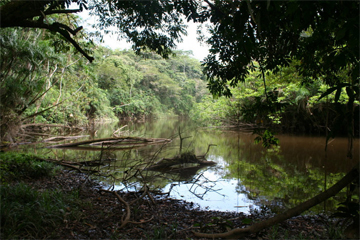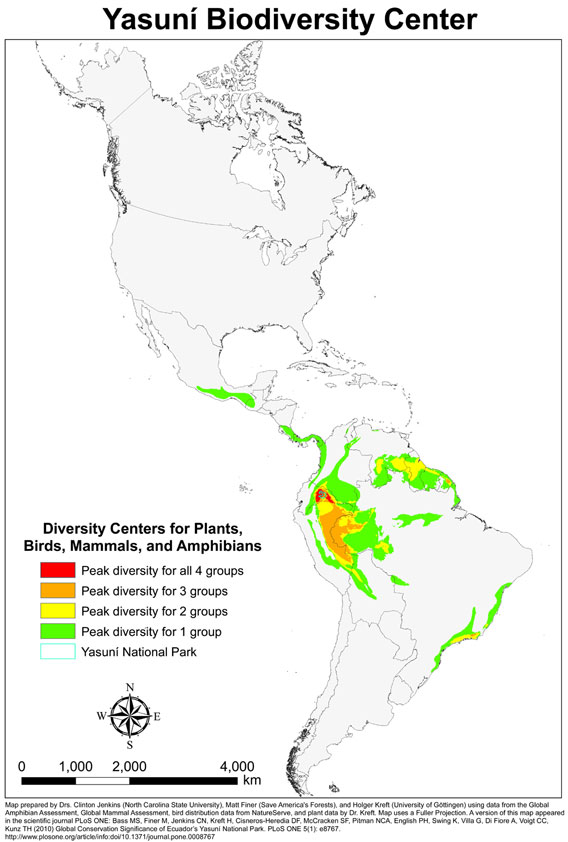
Collared puffbird (Bucco capensis) in Yasuni National Park in the Ecuadorian Amazon. Photo by: Jeremy Hance.
As the 17th Conference of the Parties to the United Nations Framework Convention on Climate Change (UNFCCC) is taking place in Durban, Ecuador has embarked on the development of a project presented as highly innovative. This project targets Yasuni National Park, which has been protected since 1979. Yasuni is home to several indigenous peoples and is a biodiversity hotspot. But it so happens that the park also sits atop a vast oil field of 846 million barrels, representing about 20 percent of the country’s oil reserves. The acronym Yasuni ITT stands for Ishpingo-Tambococha-Tiputinin, which are the names of three potential zones for oil extraction.
Three years ago, the Ecuadorian President made a proposal to the international community that his country would forgo exploiting the oil in return for financial compensation. The underlying principle of this proposal is simple: through the non-exploitation of oil, the country contributes to the reduction of greenhouse gas emissions and receives financial compensation for potential income lost. The simplicity of the project, its innovative aspects, and the benefits for local populations and biodiversity has made it particularly popular.
 An oxbow lake in Yasuni National Park, home to anacondas, piranhas, electric eels, and freshwater stingrays. Photo by Jeremy Hance. |
The United Nations Development Program (UNDP) has so far played a key role in creating the fund that would support the operation financially, and several countries have expressed interest. The funds provided (through annual payments) would amount to about $3.6 billion over 10 years. This amount relates to the market price of carbon credits, and certificates will be issued in exchange for payments (not yet eligible for trading on carbon markets). According to the available information, the rent provided would be progressively invested in various activities in favor of sustainable development: renewable energy, a network of national parks, and social and health issues.
By putting the mechanism into a realistic perspective that considers climate, the environment in general and the economy, four points stick out as problematic for the implementation of the initiative. Some are specific to the Yasuni ITT, while others apply to any project of this type.
First, the Yasuni ITT project is rich and complex. It combines many elements, ranging from oil and forest carbon storage to indigenous lifestyles and biodiversity. The simultaneous confrontation of all of these issues is possibly too good to be true. It was apparently the oil that was ultimately chosen as the basis for the financial plan and as the justification for action, because it provides the best opportunity for Ecuadorian profit. But it also makes the plan a precarious course of action with questionable (and perhaps even non-existent) global benefits as discussed below. Whatever the amount of annuities Ecuador receives, the globally shared benefits of the plan will always be precariously pitted against the oil profits that Ecuador is forgoing.
If we consider forest carbon, the REDD+ mechanism (Reducing Emissions from Deforestation and Forest Degradation) would be appropriate, but emissions resulting from tree felling to allow oil exploitation would be very low and, therefore, so would the associated payments. Perhaps biodiversity? Several ecosystem services could be linked to the preservation of the protected zone, but the relevant markets do not yet exist. Potential investors would be unable to compete with oil revenue. Regarding the indigenous peoples, the preservation of their living environment is crucial, but this represents a political decision for Ecuador, which must also consider the tantalizing prospects of oil exploitation.
Second, the issue of the project’s actual contribution to the fight against climate change must clearly be raised, since it is what justifies financial compensation (which would amount to $350 million/year for 10 years and decrease afterwards). However, this project’s climate contribution may be negligible. The project considers the extraction, and not the consumption, of oil as the generator of greenhouse gas emissions. However, the fight against climate change, as a whole, is based on the principle of assessing and reducing emissions at the level at which they occur. For example, the Kyoto Protocol formalised commitments to reduce emissions in industrialized countries by making assessments at the sectoral levels of transport and building, among others, while the option of assessing the emissions of countries that produce fossil energy was never seriously considered. And there are good reasons for this.
Let us consider two possible futures. Either all of the world’s available oil is destined for exploitation, in which case the Yasuni deposits will eventually be exploited, if only because of untenable opportunity costs due to extremely high oil prices when global supplies are depleted; or, a “low-carbon prosperity” global path prevents the exploitation of all available oil due either to a decoupling of growth and energy, or to advances in renewable energy. In this case, the preservation of the Yasuni reserves will not change the situation, since other deposits will be exploited in their place to meet demand. Such circumstances are inevitable, and nothing in the Yasuni ITT project would guard against them. In other words, the problem of “leakage” (i.e. the displacement of emissions from one place to another) is therefore inherent in the project.
 Poison dart frog (Ameerega bilinguis) in Yasuni National Park. Photo by Jeremy Hance. |
Third, the credibility of the project’s design (which requires particular care since the project is considered innovative) is a sensitive point. To begin with, it should be noted that the country is not particularly concerned about compliance with its own laws, because otherwise oil exploitation could not be considered. The area is at the heart of a National Park, and in 1989 became a UNESCO World Biosphere Reserve. Additionally, Ecuadorian legislation gives indigenous peoples the right to reject the exploitation of these lands,. Given such precedents, any promise that Ecuador makes about the future management (or even conservation) of the area would inevitably be dubious, particularly when oil prices rise, or a new government comes into power that does not perhaps share the ideas of the current one. Certainly, the project includes measures to guard against this risk through the allocation of ‘certificates’ to donors, which theoretically provide for refunding if the reserves are eventually exploited. However, given the debt history of developing countries, the considerable risk of failure cannot be totally argued away.
Fourth, while the Yasuni ITT project could make more sense if replicated over a larger scale—e.g. through similar commitments from Venezuela or Saudi Arabia—this change in scale is problematic in practice. Indeed, the cost of this type of intervention makes replication difficult. Widespread application is all the more expensive as demand is not impacted: payments occur a first time for not using this potential supply, and a second time for using an alternative supply in substitution. In other words, consumers still pay for consumption while also paying for conservation, which makes it pretty different from any other scheme than ends up paying for more environmentally-friendly production.. Additionally, the opportunity costs of non-exploitation will increase exponentially, since the absence of coupled action at the demand level will automatically lead to an increase in oil prices due to an ‘artificial’ supply scarcity.
Yasuni can be taken as a sort of “ecological blackmail,” part of a larger pattern of developing countries demanding financial compensation whenever environmental degradation and global public goods are at stake. This dynamic has already been observed during REDD+ negotiations. Many countries have sought to claim compensation for forest carbon stocks, announcing that otherwise they would be quickly exploited or cleared. Through this strategy, these countries have effectively argued that their reference scenarios (future rate of deforestation without compensation) would be very high, artificially so. This kind of compensation rationale is pervasive in the environmental field, and it may be wise to avoid giving it new opportunities for expression.
In conclusion, the innovative and initially attractive aspects of the Yasuni ITT project should not prevent stakeholders from questioning its soundness. It is an approach that, for the reasons given above, seems particularly uncertain. The situation is complex and interesting. Many issues of global importance are associated with the area’s future, and it seems important, even essential, that the area is protected from oil exploitation and the consequent damage to biodiversity and indigenous populations. However, oil extraction and the fight against climate change as the justification for international conservation funding appears to be a precarious and indefensible approach. If this approach has taken hold, it is through the “pragmatism” of an Ecuadorian government that is fully aware of the financial stakes of the different options. But this pragmatism seems largely derived from an illusion apparently shared by Ecuador and donors, in the sense that positive environmental impacts are to be expected in many fields except for climate, whereas this is presented as the rationale for payments…
The initiative therefore requires substantial modification to obtain the support of future donors if it is destined to become a pioneer project in the areas of the environment and North-South relations. To begin with, both parties should stop claiming that climate regulation stands as the main justification for the scheme and fully acknowledge that other objectives are to be pursued. In the same vein, it should also be explicitly linked to development aid in the environmental field, and biodiversity in particular. Arguably, the innovative component might be substantially minored in the end with probable implications for its visibility in the media.
According to the latest news, Germany seems to have reviewed its involvement and the necessary financial contributions will ultimately be hard to gather. The “ecological blackmail” component is all the more obvious as the president of Ecuador recently reminded the international community that if the $100 million were not pledged by the end of 2011, then oil extraction would begin right away.
Ecologists and the global justice movement, all very much in favor of this initiative, might perhaps be better inspired to focus their criticism towards the dominant development model rather than praising such moves as credible alternatives. And the activities identified by Ecuador for spending the money should be easily eligible for more classical development aid, without resorting to doubtful solutions. At least this would avoid triggering a vicious circle of blackmail and diverting attention away from fundamental issues such as development models and overall demand for energy.

Map shows Yasuni National Park is within the most biodiverse ecosystem in the Western Hemisphere if not the world. Map by Matt Finer, Clinton Jenkins, and Holger Kreft. Click to enlarge.
Related articles
New map reveals the most biodiverse place on Earth, but already threatened by oil

(09/22/2011) A new map highlights the importance of conserving Yasuni National Park as the most biodiverse ecosystem in the Western Hemisphere, and maybe even on Earth. Scientists released the map to coincide with the United National General Assembly in support of a first-of-its-kind initiative to save the park from oil exploration through international donations to offset revenue loss. Known as the Yasuni-ITT Initiative, the plan, if successful, would protect a 200,000 hectare bloc in Yasuni National Park from oil drilling in return for a trust fund of over $3 billion.
Germany backs out of Yasuni deal

(06/13/2011) Germany has backed out of a pledge to commit $50 million a year to Ecuador’s Yasuni ITT Initiative, reports Science Insider. The move by Germany potentially upsets an innovative program hailed by environmentalists and scientists alike. This one-of-a-kind initiative would protect a 200,000 hectare bloc in Yasuni National Park from oil drilling in return for a trust fund of $3.6 billion, or about half the market value of the nearly billion barrels of oil lying underneath the area. The plan is meant to mitigate climate change, protect biodiversity, and safeguard the rights of indigenous people.
Oil, indigenous people, and Ecuador’s big idea

(11/23/2010) Ecuador’s big idea—potentially Earth-rattling—goes something like this: the international community pays the small South American nation not to drill for nearly a billion barrels of oil in a massive block of Yasuni National Park. While Ecuador receives hundred of millions in an UN-backed fund, what does the international community receive? Arguably the world’s most biodiverse rainforest is saved from oil extraction, two indigenous tribes’ requests to be left uncontacted are respected, and some 400 million metric tons of CO2 is not emitted from burning the oil. In other words, the international community is being asked to put money where its mouth is on climate change, indigenous rights, and biodiversity loss. David Romo Vallejo, professor at the University of San Francisco Quito and co-director of Tiputini research station in Yasuni, recently told mongabay.com in an interview that this is “the best proposal so far made to ensure the protection of this incredible site.”